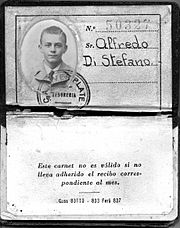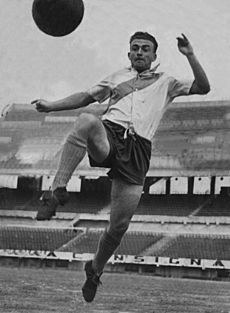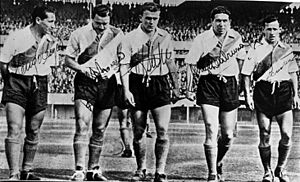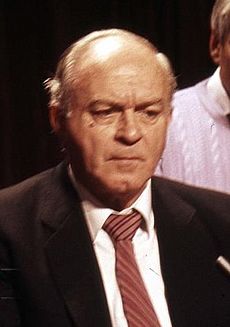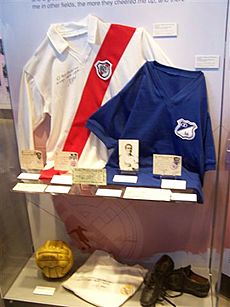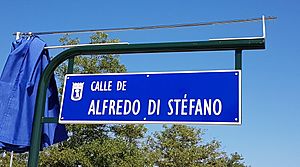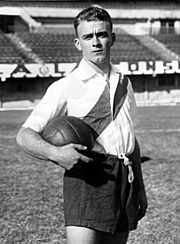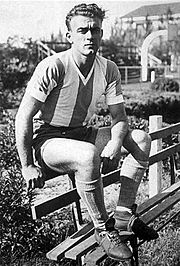Alfredo Di Stéfano facts for kids
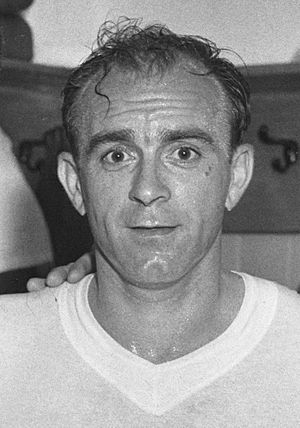
Di Stefano in 1959
|
||||||||||||||||
| Personal information | ||||||||||||||||
|---|---|---|---|---|---|---|---|---|---|---|---|---|---|---|---|---|
| Full name | Alfredo Stéfano Di Stéfano Laulhé | |||||||||||||||
| Date of birth | 4 July 1926 | |||||||||||||||
| Place of birth | Buenos Aires, Argentina | |||||||||||||||
| Date of death | 7 July 2014 (aged 88) | |||||||||||||||
| Place of death | Madrid, Spain | |||||||||||||||
| Height | 1.78 m (5 ft 10 in) | |||||||||||||||
| Position(s) | Forward, attacking midfielder | |||||||||||||||
| Youth career | ||||||||||||||||
| 1940–1943 | Unión Progresista | |||||||||||||||
| 1944–1945 | River Plate | |||||||||||||||
| Senior career* | ||||||||||||||||
| Years | Team | Apps | (Gls) | |||||||||||||
| 1945–1949 | River Plate | 66 | (49) | |||||||||||||
| 1945–1946 | → Huracán (loan) | 25 | (10) | |||||||||||||
| 1949–1953 | Millonarios | 101 | (90) | |||||||||||||
| 1953–1964 | Real Madrid | 282 | (216) | |||||||||||||
| 1964–1966 | Espanyol | 47 | (11) | |||||||||||||
| Total | 521 | (376) | ||||||||||||||
| International career | ||||||||||||||||
| 1947 | Argentina | 6 | (6) | |||||||||||||
| 1957–1961 | Spain | 31 | (23) | |||||||||||||
| Managerial career | ||||||||||||||||
| 1967–1968 | Elche | |||||||||||||||
| 1969–1970 | Boca Juniors | |||||||||||||||
| 1970–1974 | Valencia | |||||||||||||||
| 1974 | Sporting CP | |||||||||||||||
| 1975–1976 | Rayo Vallecano | |||||||||||||||
| 1976–1977 | Castellón | |||||||||||||||
| 1979–1980 | Valencia | |||||||||||||||
| 1981–1982 | River Plate | |||||||||||||||
| 1982–1984 | Real Madrid | |||||||||||||||
| 1985 | Boca Juniors | |||||||||||||||
| 1986–1988 | Valencia | |||||||||||||||
| 1990–1991 | Real Madrid | |||||||||||||||
|
Medal record
|
||||||||||||||||
| *Club domestic league appearances and goals | ||||||||||||||||
Alfredo Stéfano Di Stéfano Laulhé (born 4 July 1926 – died 7 July 2014) was an amazing footballer and coach from Argentina. Many people think he was one of the greatest players of all time. He was nicknamed "Saeta rubia" which means "Blond Arrow" because he was so fast.
Di Stéfano is most famous for his time with Real Madrid. He helped the club win many titles, including the European Cup five times in a row! He even scored goals in all five of those finals. After moving to Madrid, he played international football mostly for Spain. He also played for Argentina and a team in Colombia.
He started his career at River Plate in Argentina when he was just 17. Later, he moved to Millonarios in Colombia. He won six league titles in Argentina and Colombia before joining Real Madrid. At Real Madrid, he became a key player in one of the most successful teams ever. He scored 216 league goals for Real Madrid. He also scored 49 goals in the European Cup, which was a record for a long time.
One of his most famous games was the 1960 European Cup final. Real Madrid beat Eintracht Frankfurt 7–3. Many people say it was one of the best club football games ever. Di Stéfano won the Ballon d'Or award twice, in 1957 and 1959. This award is for the best footballer in Europe. He is still one of the top goal scorers in Spain's top league, La Liga.
Contents
Early Life and First Steps
Alfredo Di Stéfano was born in Barracas, a neighborhood in Buenos Aires, Argentina. His father was from Italy, and his mother had French and Irish family.
Alfredo's father used to play for River Plate. He taught young Alfredo about football. Alfredo grew up playing street football. People quickly noticed how talented he was. In 1940, his family moved to the countryside. Alfredo played for a local club there until 1943, when they returned to Buenos Aires.
Club Career Highlights
Starting at River Plate
In 1944, Di Stéfano's father helped him get a tryout with River Plate. He impressed everyone and joined their youth team. The next year, he joined the first team. This team was known as La Máquina (The Machine) because they were so successful.
Di Stéfano looked up to Paraguayan striker Arsenio Erico. He learned a lot from the older stars on his team. His coach taught him to keep the ball low. He made his first team debut in 1945 when he was 19. River Plate won the championship that year, which was his first title.
Loan to Huracán
After his first game, the president of Huracán was impressed by Di Stéfano. He joined Huracán on loan because he wanted more playing time.
His coach at Huracán, Guillermo Stábile, gave him a real chance. He scored his first two goals in a 3–1 win. He even scored against his old team, River Plate. It was one of the fastest goals in Argentine history! He scored 10 goals in 25 games for Huracán. Huracán wanted to sign him permanently, but they couldn't afford it.
Back to River Plate
When Di Stéfano returned to River Plate, he became a very important player. He took over the central forward role. His teammates learned to play around him. A journalist gave him the nickname Saeta Rubia (Blond Arrow).
He helped River Plate win the 1947 Argentine Primera División title. He was the top scorer in the league with 27 goals. River Plate also won the Copa Aldao, an international club trophy. In 1948, players went on strike in Argentina. This caused many top players, including Di Stéfano, to leave for other leagues.
Time with Millonarios
After the strike, Di Stéfano moved to Colombia. He joined Millonarios in Bogotá in 1949. Many international stars joined the Colombian league during this time.
Di Stéfano and his teammates formed a famous team called the Ballet Azul (Blue Ballet). They won their first title in 1949. Di Stéfano scored 16 goals in 14 games that season. He led Millonarios to two more titles in 1951 and 1952. He was the top scorer in the league both years. He scored a total of 267 goals in 292 games for Millonarios. He is considered one of the best players in Colombian league history.
Moving to Real Madrid
In 1952, Real Madrid invited Millonarios to a tournament in Spain. Di Stéfano played wonderfully, scoring two goals against Real Madrid. Real Madrid's president, Santiago Bernabéu, was very impressed.
Both Real Madrid and Barcelona wanted to sign Di Stéfano. There was a big dispute over who had the rights to him. FIFA, the world football body, had to step in. Eventually, Real Madrid signed him in 1953. This transfer made the rivalry between Real Madrid and Barcelona even stronger.
Real Madrid: European Dominance

Di Stéfano joined Real Madrid when he was 27. He quickly made an impact. He scored his first goal for Real Madrid in his first game. In his first "El Clásico" match against Barcelona, he scored two goals in a 5–0 win.
Real Madrid won the Spanish championship in his first season. Di Stéfano was the top scorer with 27 goals. The next year, Real Madrid won another league title. They also won their first Latin Cup in 1955.
Real Madrid then played in the first-ever European Cup in 1955–56. Di Stéfano helped his team reach the final in Paris. Real Madrid won the trophy 4–3. Di Stéfano almost won the first Ballon d'Or award that year.
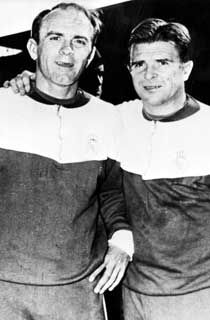
In 1956, Di Stéfano became a Spanish citizen. This allowed Real Madrid to sign more foreign players. They signed Raymond Kopa and later Ferenc Puskás. These players, along with Di Stéfano and Francisco Gento, formed one of the best attacks in football history.
Real Madrid continued to dominate. They won the European Cup five times in a row, from 1956 to 1960. Di Stéfano scored in every one of those finals. He also won the Ballon d'Or in 1957 and 1959. Real Madrid also won more league titles during this time.
In 1960, Real Madrid won the first Intercontinental Cup. They beat Peñarol from Uruguay. Di Stéfano scored a goal in the final.
Later Years and Retirement
Real Madrid won more league titles in the early 1960s. In 1962, they won the Spanish Cup for the first time in 15 years. Di Stéfano played his last season for Real Madrid in 1963–64. He helped them win their fourth league title in a row.
Di Stéfano played for Real Madrid for 11 years. He won 8 Spanish championships, 1 Spanish Cup, 2 Latin Cups, 5 European Cups, and 1 Intercontinental Cup. He scored 418 goals in 510 games for the club. This made him the club's top scorer for many decades.
After leaving Real Madrid in 1964, Di Stéfano joined Espanyol. He played there for two seasons. He retired as a player in 1966, at the age of 40.
International Career
Di Stéfano played for three different national teams during his career. He scored 6 goals for Argentina and 23 goals for Spain. However, he never played in a World Cup.
Playing for Argentina
Di Stéfano first played for Argentina in 1947. He scored his first international goal in a 7–0 win. He scored five more goals in that tournament, including a hat-trick. Argentina won the championship that year.
These six games were his only appearances for Argentina. Player strikes and other issues prevented Argentina from playing in the World Cup. FIFA also later ruled that he couldn't play for Argentina anymore because he had played for a Colombian team.
Playing for Colombia (Unofficial)
After moving to Colombia in 1949, Di Stéfano played four times for a Colombian team. These games were friendly matches and not officially recognized by FIFA. He did not have a Colombian passport.
Playing for Spain
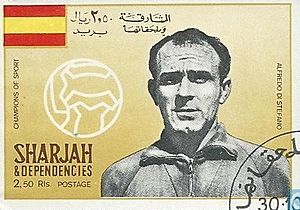
Di Stéfano was very popular in Spain. After becoming a Spanish citizen in 1956, FIFA allowed him to play for Spain. He made his debut for Spain in 1957, scoring three goals in a 5–1 win.
Spain, with Di Stéfano, was expected to qualify for the 1958 FIFA World Cup. But they didn't make it. Di Stéfano played in all four qualification games and scored two goals.
In 1961, at age 35, Di Stéfano finally helped Spain qualify for the 1962 FIFA World Cup. However, he got a muscle injury just before the tournament. He traveled with the team but couldn't play. Spain didn't make it out of the group stage. Di Stéfano retired from international football after this tournament.
Managerial Career
After he stopped playing, Di Stéfano became a coach. He led the Argentine club Boca Juniors to a league title. He also won La Liga and the European Cup Winners' Cup with Valencia. He helped Valencia return to La Liga after they were relegated.
He also managed Sporting and Real Madrid. During his time as Real Madrid manager from 1982 to 1984, they finished second in La Liga twice. They also reached several cup finals but didn't win them. He later won the Supercopa de España with Real Madrid in 1990.
After Retirement
Di Stéfano lived in Spain until he passed away in 2014. On 5 November 2000, he was named Honorary President of Real Madrid.
On 9 May 2006, the Alfredo Di Stéfano Stadium was opened. This is where Real Madrid's training ground is. The first match there was a friendly game between Real Madrid and Stade de Reims, a rematch of the 1956 European Cup final.
Style of Play
Di Stéfano was known as a very strong and fast player. He was skillful and scored many goals. He had great stamina and could play almost anywhere on the field. He was excellent at dribbling past defenders. He also scored amazing goals using volleys and bicycle kicks.
Death
Alfredo Di Stéfano had a heart attack on 5 July 2014. He passed away on 7 July 2014, at the age of 88.
His coffin was placed on public display at the Santiago Bernabéu Stadium, Real Madrid's home ground. Many famous football players and coaches shared their sadness. During the 2014 FIFA World Cup semi-final, a minute of silence was held for him. The Argentine team also wore black ribbons to show their respect.
In September 2017, a street near Real Madrid's training complex was named after him.
Career statistics
Club
| Club | Season | League | Cup | Continental | Total | |||||
|---|---|---|---|---|---|---|---|---|---|---|
| Apps | Goals | Apps | Goals | Apps | Goals | Apps | Goals | |||
| River Plate | 1945 | Argentine Primera División | 1 | 0 | 0 | 0 | 0 | 0 | 1 | 0 |
| Huracán (loan) | 1946 | Argentine Primera División | 25 | 10 | 2 | 0 | 0 | 0 | 27 | 10 |
| River Plate | 1947 | Argentine Primera División | 30 | 27 | 0 | 0 | 2 | 1 | 32 | 28 |
| 1948 | Argentine Primera División | 23 | 13 | 1 | 1 | 6 | 4 | 30 | 18 | |
| 1949 | Argentine Primera División | 12 | 9 | 0 | 0 | 0 | 0 | 12 | 9 | |
| Total | 66 | 49 | 1 | 1 | 8 | 5 | 75 | 55 | ||
| Millonarios | 1949 | Campeonato Profesional | 15 | 15 | 0 | 0 | 0 | 0 | 14 | 14 |
| 1950 | Campeonato Profesional | 29 | 23 | 2 | 1 | 0 | 0 | 31 | 24 | |
| 1951 | Campeonato Profesional | 34 | 31 | 0 | 0 | 0 | 0 | 34 | 31 | |
| 1952 | Campeonato Profesional | 24 | 19 | 8 | 5 | 0 | 0 | 32 | 24 | |
| Total | 102 | 88 | 10 | 6 | 0 | 0 | 111 | 93 | ||
| Real Madrid | 1953–54 | La Liga | 28 | 27 | 0 | 0 | 0 | 0 | 28 | 27 |
| 1954–55 | La Liga | 30 | 25 | 0 | 0 | 2 | 0 | 32 | 25 | |
| 1955–56 | La Liga | 30 | 24 | 0 | 0 | 7 | 5 | 37 | 29 | |
| 1956–57 | La Liga | 30 | 31 | 3 | 3 | 10 | 9 | 43 | 43 | |
| 1957–58 | La Liga | 30 | 19 | 7 | 7 | 7 | 10 | 44 | 36 | |
| 1958–59 | La Liga | 28 | 23 | 8 | 5 | 7 | 6 | 43 | 34 | |
| 1959–60 | La Liga | 23 | 12 | 5 | 3 | 6 | 8 | 34 | 23 | |
| 1960–61 | La Liga | 23 | 21 | 9 | 8 | 4 | 1 | 36 | 30 | |
| 1961–62 | La Liga | 23 | 11 | 8 | 4 | 10 | 7 | 41 | 22 | |
| 1962–63 | La Liga | 13 | 12 | 9 | 9 | 2 | 1 | 24 | 22 | |
| 1963–64 | La Liga | 24 | 11 | 1 | 1 | 9 | 5 | 34 | 17 | |
| Total | 282 | 216 | 50 | 40 | 64 | 52 | 396 | 308 | ||
| Espanyol | 1964–65 | La Liga | 24 | 7 | 3 | 2 | 0 | 0 | 27 | 9 |
| 1965–66 | La Liga | 23 | 4 | 4 | 1 | 6 | 0 | 33 | 5 | |
| Total | 47 | 11 | 7 | 3 | 6 | 0 | 60 | 14 | ||
| Career totals | 521 | 373 | 70 | 50 | 78 | 57 | 669 | 480 | ||
International
| National team | Year | Apps | Goals |
|---|---|---|---|
| Argentina | 1947 | 6 | 6 |
| Total | 6 | 6 | |
| Spain | 1957 | 7 | 7 |
| 1958 | 4 | 1 | |
| 1959 | 5 | 6 | |
| 1960 | 8 | 6 | |
| 1961 | 7 | 3 | |
| Total | 31 | 23 | |
| Career total | 37 | 29 | |
Honours
PlayerRiver Plate
Millonarios
Real Madrid
Argentina Individual
|
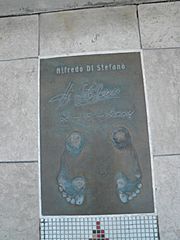
Manager
Boca Junior
- Primera División: 1969
- Copa Argentina: 1969
River Plate
- Torneo Nacional: 1981
Valencia
- La Liga: 1970–71
- European Cup Winners' Cup: 1979–80
- Segunda División: 1986–87
Real Madrid
- Supercopa de España: 1990
Records
- Scored in most European Cup finals: five
- Scored in most consecutive European Cup finals: five
- Most goals scored in European Cup finals: seven (shared with Ferenc Puskás)
- Only player to be awarded the Super Ballon d'Or
See Also
 In Spanish: Alfredo Di Stéfano para niños
In Spanish: Alfredo Di Stéfano para niños
- List of men's footballers with 500 or more goals
Images for kids


